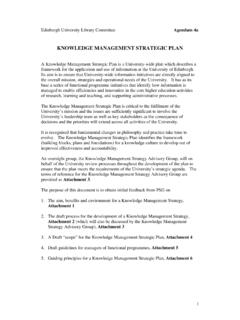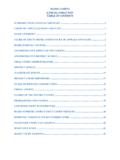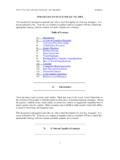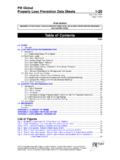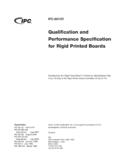Transcription of Creating a table of contents quickly in Word
1 Creating a table of contents Creating a table of contents quickly in Word quickly in Word This note shows you how to set up a table of contents that can be generated and updated quickly and easily, even for the longest and most complex documents. Using styles The key to Creating a quick and easy contents page is to use Word's built-in heading styles, that is, Heading 1, Heading 2, Heading 3 etc. Once you have applied these styles to the headings in your document, you can use Word's table of contents function to do all the hard work for you. For more information on using styles see Making your documents look good: using MS.
2 Word the easy way. Creating a basic table of contents Once you have applied heading styles, you can create your table of contents : Click where you want the contents to appear. From the menu, select Insert Reference Index and Tables. The Index and Tables dialog box displays. Click the table of contents tab. The Print Preview box on the left shows you how your table of contents will look. The settings for your contents appear below the preview box. You will find that most of the options you need are already selected. Your contents will show page numbers, have right-aligned page numbers, and a tab leader (the character that appears between the contents entry and the page number).
3 You can change the tab leader if you wish, for example you may want a different one, or no tab leader at all. Word shows three levels by default, that is, the text from the paragraphs to which you have applied the styles Heading 1, Heading 2 and Heading 3 will appear in your table of contents . You can use the Show levels box to generate more or fewer levels. Make sure the option From template is selected in the Formats box so that you use the table of contents (TOC) styles that are automatically included in the document you are working on. When you have made your selections, click OK. Your table of contents is displayed: Don't apply a heading style to your table of contents heading you don't want it appearing on your contents list!
4 You can create a custom style or format the text manually. Updating a table of contents If you make changes to your document, for example you might add or delete sections, or alter the text of a heading, Word does not automatically update the table of contents . You must remember to do this yourself. To perform the update, click anywhere in the table of contents and press F9 to display the Update table of contents box. You can choose to update page numbers only, or the entire table . It is a good idea to always choose to Update entire table in case you have made any other changes. Click OK to start the update. Always update your table of contents before sending out or printing the document so that any changes are included.
5 This will also avoid the Error! Bookmark not defined message appearing in your contents . You can set Word to always update tables of contents automatically when you print. Select Tools - Options - Print and click the Update Fields box. Modifying a table of contents The entries in a table of contents are not ordinary text; they are fields. Although there is nothing to stop you editing the entries directly, any changes you make will be lost when you perform an update. To change the wording of entries, you must change the text in the document itself, then press F9 to update the contents . If you want to change the way the text in your table of contents looks, , font type, size, etc.
6 , you can do this through the Index and Tables dialog box: Click anywhere in the table of contents and select Insert Reference Index and Tables. Click the Modify button at the bottom right. Word includes nine built-in table of contents styles corresponding to the nine heading levels. These appear as TOC1, TOC2 etc. (The symbol indicates the style of the paragraph your cursor was in when you clicked Modify.). Click on the style you want to change and click Modify. The Modify Style dialog box displays. Make changes to the formatting as required and click OK. Select another style to modify and repeat. When you have completed the editing, click OK to exit.
7 Click OK to replace the table of contents . Note: You can also make formatting changes to TOC styles by using the Styles and Formatting task pane. Click in the table of contents just in front of the page number. The style appears in the Formatting of selected text box: Move your cursor to the box, click on the down arrow and click Modify. Note that the TOC styles do not appear in the Pick formatting to apply list, even if you select All styles. Including custom styles If you have a document that uses custom styles as well as, or even instead of, the built-in heading styles, you can include these in the table of contents .
8 Click where you want the contents to appear and select Insert Reference Index and Tables. At the table of contents tab, click the Options button. The table of contents Options box displays. The built-in heading styles are selected by default in the Available styles list. You select which style goes with which level by typing in the TOC level number. You can mix and match' built-in and custom styles as you wish. As an example, you may have created custom styles called Appendix 1 and Appendix 2, and you want the text for these entries to appear on the table of contents at the same levels as Heading 1 and Heading 2. All you need to do is scroll the Available styles list to find your custom styles then type in the levels: Your table of contents will include the entries where the styles Appendix 1 and Appendix 2 have been applied: Including a table of figures If you have figures (such as diagrams, tables or images) in your document, you can include entries for these in your table of contents .
9 This is done by Creating a caption for each figure, then inserting a table of figures. To create a caption: Click the figure and select Insert Reference Caption. At Label, select the label for the object. The default list is Equation, Figure or table . You can create a new label if nothing on the list is appropriate. In the Caption box, click after the label and add any descriptive text you wish. Select the Position for the caption and click OK. To insert the table : On your contents page, click where you want the table of figures to appear. Select Insert Reference Index and Tables and click the table of Figures tab. At Caption label, select the label from the list.
10 Select any other options you require and click OK. You can create as many tables of figures as you need. Note that each table has to be updated separately. A. quick way to do this is to select Edit Select All then press F9. An Update table of contents prompt will appear for each table . Tips, tricks and troubleshooting I have unwanted entries in my table of contents A common problem with a table of contents is to find rogue' entries. In the example below, an entire paragraph has appeared in the contents . This happens when a style used to create the contents has been applied to a paragraph. This may have been done inadvertently, in which case simply locate the paragraph and apply another style.




